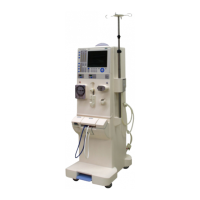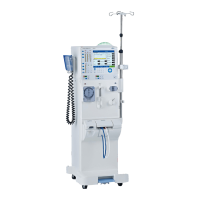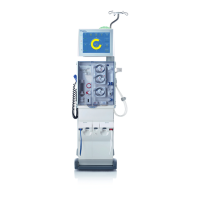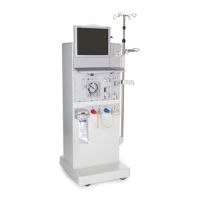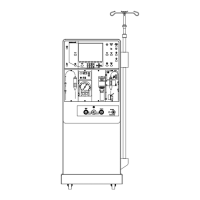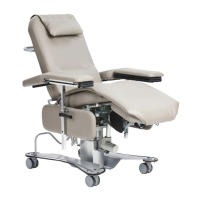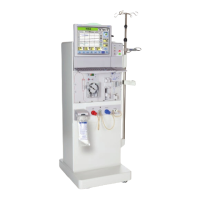Fresenius Medical Care 4008 HDF 3/11.97 (TM) 4-23
4.3 LP 760 HDF motor control
4.3.1 Description
● General
The LP 760 serves to control the lift drive.
Lift operation presupposes that the scales are swung away. This is recognized by a limit switch.
The scales can be moved upwards or downwards by pressing the ▲ or ▼ keys. The drive is
switched off automatically, likewise by limit switches, when reaching the uppermost or bottom-
most position. When the scales are being travelled upwards or downwards they can be stopped
at any time with the Stop key.
The motor for the lift drive is safeguarded against overloading by means of an integrated
thermoswitch. If this protection facility responds the lift will come to a standstill. The lift can be
used again after the motor has cooled down.
● Circuit structure
Supply voltage
The control circuit is supplied with +12 V. This voltage is generated from the +24 V voltage of the
hemodialysis machine by the linear controller T1 in conjunction with the capacitors C4, C5 and
C6.
Motor control
Two types of circuit are implemented to control the motor:
a) continuous operation (R21 with components, R22 without components
b) inching operation for downwards movement (R21 without components, R22 with
components).
To Point a):
One D flip-flop is available for each direction of movement (IC 3). The flip-flops are set by a high
level on X2/2 (key ▲) or X2/4 (key ▼). The flip-flop for the respective other direction of movement
is reset at the same time by pressing the appropriate key. The two flip-flops are reset through high
level on X2/3 (Stop key). This also takes place should the head of the scales be swung over the
machine (high level on X1/6).
To Point b):
There is only one flip-flop available for the upwards movement (IC 3/pin 1/2). The flip-flop for the
downward movement is set through IC 5. The control logic for the downward operation is not
influenced by this (see Point a). However, the drive is only active as long as the key ▼ is pressed.
The IC 5 works as an 8 to 1 multiplexer. The address (0 to 7) of the input to be interconnected is
provided through the pins 11 to 13. Only the address 3 leads to a low level on output IC 5/14 and,
as a result, to the motor starting. R 20 serves as a pull-up resistor. A defined output level is
obtained with the IC 5/14 in high ohmic state, caused by pressing the Stop key (high level on IC
5/15).

